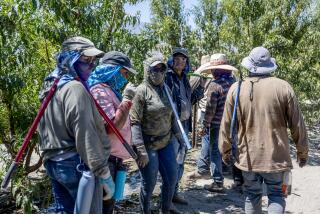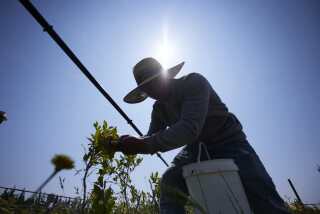COLUMN ONE : Anger in the Aussie Outback : Rural Australia is feeling desperate. Unemployment has soared while farm prices have sunk. The United States is blamed, and President Bush is likely to take some heat.
- Share via
KALGOORLIE, Australia — The 3:30 p.m. whistle shrieked across the desert as a grimy elevator cage rumbled up from cold darkness half a mile underground. But it was more than another shift change at one of Australia’s richest and most fabled gold mines. After 98 years, the old Lake View mine was closing.
“It’s history,” said George Malec, a miner for 35 years, dirt-blackened and blinking as he stepped into the sunlight. “Bitter? You bet I’m bitter. When it comes your time, you get a kick in the arse and told goodby Charlie.”
Across the continent, 65-year-old John Sloan seems as hardy as the famed woolly Merino sheep he raises on his 15,000-acre farm. If Australia rode to prosperity “on a sheep’s back,” as the saying goes, men like Sloan and his ancestors led the way.
Inside his drafty barn, the tall, balding sheepman worried aloud as six sweating farmhands sheared his flock with electric clippers. Oversupply of sheep drove prices so low early this year that he and other anguished farmers were forced to shoot and bury 12 million surplus animals.
“It sounds terrible, but the cheapest way to get rid of them was shoot them,” said Sloan, who destroyed 800 sheep. “I couldn’t give them away.
“There’s gonna be a lot of farmers who will go out of business,” he added glumly. “They’re gonna go down the gurgle.”
These are hard times in a hard land. Long the country’s economic mainstay and cultural icon, rural Australia is fighting a losing battle as the nation suffers its worst recession and highest unemployment in decades. A sharp drop in world prices for wool, wheat and cattle and a devastating drought in the breadbasket states of Queensland and New South Wales have only added to rural woes.
“I’ve never seen it this bad,” said Roy Ballard, owner of the drought-stricken Gum-Hole farm, about 380 miles northwest of Sydney. “There’s been a total crop failure out here. . . . It’s very like Oklahoma in the 1930s.”
Indeed, faced with the worst grain harvest in 20 years, officials say Australia may have to import wheat from Canada and the United States next year to supply its own bakeries. Even so, protests are planned during President Bush’s visit to Australia, which begins today. Angry farmers say America is stealing Australia’s export markets with cheaper, subsidized wheat. U.S. officials say subsidies are needed to compete in a global wheat war with the European Community.
“I wouldn’t rule out brief and quite violent demonstrations,” said Alex Nicol, spokesman for the Australian Wheat Board. “These are fairly desperate people.”
Australia long has been the world’s largest producer and exporter of wool, lamb and mutton and a leading exporter of beef and veal. But a sharp drop in worldwide wool prices and removal of government price supports last February left farmers reeling: Prices plummeted by one-third. Today, the Australian Wool Corp., the growers’ organization, has 4.5 million bales of unsold wool and more than $2 billion in debts.
And much like the American Midwest, farm families are hurting. With aging equipment and growing debts, a record number are applying for emergency aid, including a two-week-old program that offers unemployment benefits to out-of-work farmers.
Worse, reports of rural suicide, alcohol abuse and domestic violence have risen dramatically.
“The human side is pretty grim,” said Rick Farley, executive director of the National Farmers’ Federation. A recent government report estimates that 82% of the country’s 126,000 farms will lose money this year, he said. “We’re looking at a basic revolution in the social structure of Australian agriculture. I firmly believe the future of family farms in Australia is at risk.”
Actually, most of Australia’s 17 million people live in Sydney, Melbourne and other big cities in coastal regions that make up about a third of the country. Away from the coast, one-third of the country is outback, the furnace-like desert that early European explorers called a crucible and modern Australians call Never Never, Woop Woop and much that’s unprintable. Another third is semi-arid, with poor soil and little rain. Some cattle ranches there are bigger than Connecticut.
“Most people don’t realize Australia always has been one of the most urbanized societies in the world,” said Donald Horne, an historian and writer. “Much more than the U.S.”
But rural life here looms larger than its numbers. Like America and its Wild West, Australia’s cultural identity is bound to the bush and the idea of fighting the harsh frontier.
A popular TV soap opera, for example, focuses on the Rural Flying Doctor Service, a national network of airborne ambulances that provide medical care for most rural areas. The group’s busiest base is in Kalgoorlie, in Western Australia. Responding to telephone and radio calls, seven doctors and nurses fly off daily to treat mining accidents, deliver babies, patch gunshot and spear wounds and otherwise assist 55,000 people scattered over an area greater than Texas, including the fierce Gibson Desert.
“Most of the flying is done at night onto bush strips, using car headlights and a few bonfires on the side,” said Syd Winchcomb, general manager at the radio base.
Kalgoorlie is 370 miles east of Perth, a straight two-lane shot to the outback from the continent’s western edge. Except for tiny, two-dog towns that break the bleak horizon, scores of road-killed kangaroos and ostrich-like emus are the only mile markers amid the endless expanse of saltbush and gum trees.
Australia’s most significant gold mining town has endured since 1893, when Paddy Hannan stumbled on a mound of nuggets. The hapless Irish prospector died penniless, but the Golden Mile he discovered has been called the world’s richest square mile of dirt. So far, it’s yielded at least $650 million worth of gold.
Flanked by shabby Victorian-era hotels and ever-busy pubs, Kalgoorlie’s main street was laid out extra-wide, so that imported Afghan camel trains, which once hauled supplies in and gold out, could turn around. Camels are now bred here for export to the Middle East. And on a muddy field out of town, past a sad street of tin-shed brothels, miners still gamble their paychecks by flipping coins in a no-skill game called “two-up.”
Over the years, Kalgoorlie boomed, went bust and boomed again. As alluvial gold panned out, miners went underground. Hundreds of head-frames sprouted, each marking a separate shaft. A few derricks still rust silently by the ugly mounds of gray tailings that scar the land beside long-closed mines.
But the Lake View was different. Come good times and bad, hundreds of men worked the labyrinth of tunnels along the 2,800-foot-deep shaft. Foreman Matt Saviaur even found a 1901 newspaper recently in a disused tunnel. “It said the streets of Kalgoorlie are paved with gold,” he said with a laugh.
No longer. The Lake View closed on July 19, the last of the major mines. The last of its 250 miners were laid off, victims of a future called the Super Pit. Gargantuan trucks and monster earthmovers already are gouging a giant, two-by-three-mile hole to replace the shaft mines and most of the miners. Ultimately, the whole Golden Mile will be scooped out for gold.
“I suppose I’ll go down in local history as the man who closed underground mining,” said Ian Burston, head of the company that manages the pit. “But it was inevitable. Time and technology caught up with this damn business.”
He paused. “There’s a romance to underground mining compared to open pit mining,” he said. “The miner was the man in the ground, not digging bloody quarries.”
Many see another kind of romance on the sheep stations.
The Kilnyana farm has been in John Sloan’s family, for example, since his Scottish grandfather rode a horse 195 miles north from Melbourne in the 1860s. Along the winding Murray River, the low, rolling hills and stands of pine are perfect for Merino sheep, famed for their thick fleece and fine wool.
Sloan and his wife, Margaret, live in the ancestral homestead, a sprawling house with 18-inch-thick, pressed-mud walls, huge fireplaces and rooms full of antique furniture brought by their forebears. Faded photos of Victorian figures hang on the walls. One print shows 34 men baling wool, as Sloan’s father supervised in a pith helmet. “Now one man and a machine can do it,” said Sloan, peering at the picture over a salt-and-pepper mustache.
Next morning dawned cold and damp. Wearing a wool cap and mud-splattered down coat, Sloan and his 33-year-old son, Bill, roared out on four-wheel motorbikes to muster some of their 10,000 sheep. Barking Kelpie sheep dogs helped herd the frightened animals through swinging gates and down chutes to the shearing shed.
“Here, Billy! Here, Billy!” Sloan shouted as his lead dog scampered over the backs of sheep in the chute. He turned with a laugh. “She’s as old as the hills. As old as I am.”
Six shearers were already busy in the shed. Each man held a sheep in his legs and somehow stripped the soft fleece in under three minutes with electric clippers. Others sorted and graded the wool. It is back-breaking labor, but they worked at feverish pace. By day’s end, they had shorn 1,043 sheep. They had also consumed an entire sheep, plus beans and bread, for lunch.
Outside, Sloan’s son daubed green paint to brand the naked-looking, newly shorn year-old castrated rams. Prices for full-grown sheep, he said, have fallen from $75 to $11 in four years. The price of a 200-kilogram bale has dropped in half.
“Now no one knows what the price of sheep is,” he said. “It’s collapsed. It’s a new ballgame.”
He climbed into a Toyota Land Cruiser with a shotgun in back and steel “roo bars” on the grill in case it hit kangaroos. Minutes later, bouncing along a muddy back paddock, four huge hopping ‘roos suddenly sprinted alongside. As the car sped to 30 m.p.h., the kangaroos kept up until they found a low spot in the fence. Then they leaped over and were gone. “Bloody nuisance,” he said good-naturedly.
In a good year, Kilnyana earns $157,000 from its wool and wheat. But for the first time in the farm’s history, rains fell so heavy and so late this year that the Sloans couldn’t plant wheat in the flooded fields.
“As a farmer, you’re always in debt,” said the younger Sloan. “But this year we’re not gonna have a chance of wiping it off. Wool is too low, there’s no wheat and the price of sheep is down. We’ll have a cash flow problem.”
Sloan says he’ll survive. But “For Sale” signs hang on some of his neighbors’ fences, and he fears that banks will foreclose. If they do, he said, he and others will boycott the sales. “It’s stand by your neighbor,” he said. “It’s our code of ethics in the bush.”
But the bush is changing, and Australia with it. “The crunch is coming,” he said. “This year is going to be the death knell for a lot of farms.”
More to Read
Sign up for Essential California
The most important California stories and recommendations in your inbox every morning.
You may occasionally receive promotional content from the Los Angeles Times.











